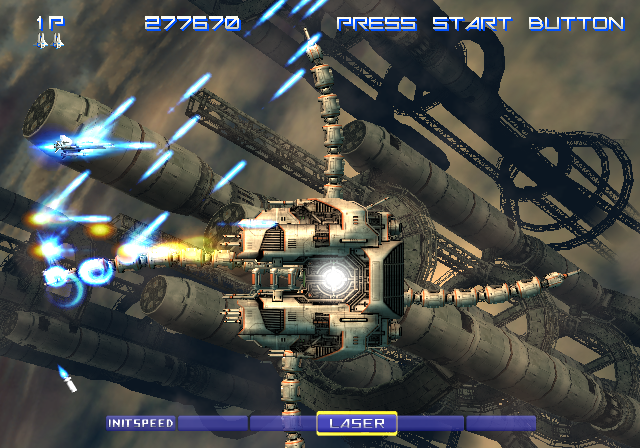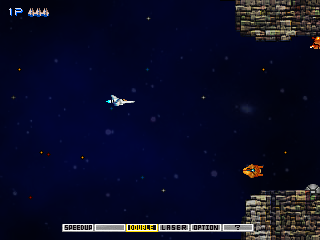

- #Gradius gaiden translate upgrade#
- #Gradius gaiden translate full#
- #Gradius gaiden translate series#
It’s no wonder that this weapon selection mechanic was retained and deepened in later sequels. It allows for multiple play styles and encourages players to re-play the game in order to experiment with new ways to tackle old challenges. Do you prefer the more damaging straight laser from Gradius or the extra screen coverage of Life Force’s wider ripple laser? How about missiles that travel along the ground, double missiles, or exploding bombs that deal heavy splash damage to anything nearby? Double shot or tail gun? No one weapon set imbues the Vic Viper with flawless 360 degree firepower, so choose wisely. Four different sets of armaments are available, each of which has its own strengths and weaknesses. Every weapon from Gradius and Life Force is available, along with some new ones, but the catch is that you can’t take them all with you.
#Gradius gaiden translate upgrade#
New to this entry is the ability to customize the upgrade menu itself at the beginning of each playthrough. Certain enemies drop orange orbs that you can collect and then cash in to purchase upgrades for the Vic Viper.
#Gradius gaiden translate full#
The classic Gradius power-up system is in full effect here. Giger airbrush painting and “facehugger” baddies that spring from their eggs to assault the Vic Viper. I particularly enjoyed Gradius II’s Alien-inspired second stage, which is sporting phallic bio-mechanical skulls straight out of an H.R. Thankfully, the level roster isn’t made up entirely of callbacks. Gradius II’s opening stage has you dodging between colossal solar flares straight out of Life Force, for example, and level four is a murderous moai head gauntlet patterned on the first game’s. Many of the individual areas you’ll visit are clearly meant to be amped-up takes on ones seen in previous entries.

A “perfect” playthrough clocks in at around 26 minutes, versus the original’s 16 or so. Even though this is only one more than Gradius featured, the stages here are considerably longer on average. The conflict plays out over a total of seven stages. Meanwhile, across the table, an equally inebriated Doh from Taito’s Arkanoid nods morosely. I like to picture him down at the local space bar crying into his space beer about how nobody respects him.

Yes, the villain here is actually called Gofer, which has to be one of the least fortunate evil alien overlord names in sci-fi history. Planet Gradius is in peril once more and you’re the only pilot that has what it takes to save your world from the bloodthirsty Bacterians and their new leader, Gofer. What’s going on in the game? About what you’d expect. Whether this technical limitation was the sole reason Gradius II never saw an international release is an open question, though it seems likely to have been a significant factor at the very least. In stark contrast to the “anything goes” Famicom scene, Nintendo prohibited third party developers from manufacturing their own cartridges and custom mappers for the NES. Spectacular as the end result is, the VRC4 itself may have also limited the game’s distribution. Konami relied on a custom memory mapper chip called the VRC4 to push the Famicom beyond its normal limits for Gradius II. It’s not a perfect re-creation of the arcade game, which was one of the most cutting edge cabinets out at the time, but it’s a sight to behold nonetheless. Experienced players will recognize many of the same level concepts, power-ups, and enemies from Gradius and Life Force, just presented with a greater degree of intensity and audiovisual polish than ever before. The Famicom Gradius II is the epitome of the bigger, louder, faster, harder approach to sequel design. As a nice little bonus, I get to play this Famicom port, which is famous for being both one of the most technically impressive games for the system and one of its highest profile Japanese exclusives. Now it’s finally time to move on to the first true numbered sequel with Gradius II. I’ve gone back to finish the original Gradius and even took a delightful detour into the Parodius sub-series of comedic shooters. Ever since I set my reservations aside and ended up having a blast with the Gradius spin-off Life Force in the summer of 2017, however, I’ve been hooked on laying waste to those Bacterian scum in my trusty Vic Viper starship.

#Gradius gaiden translate series#
Much to my surprise, as a frustrating adolescent experience with the arcade original put me off the series for decades. I’ve grown into a huge Gradius fan over the last couple of years.


 0 kommentar(er)
0 kommentar(er)
